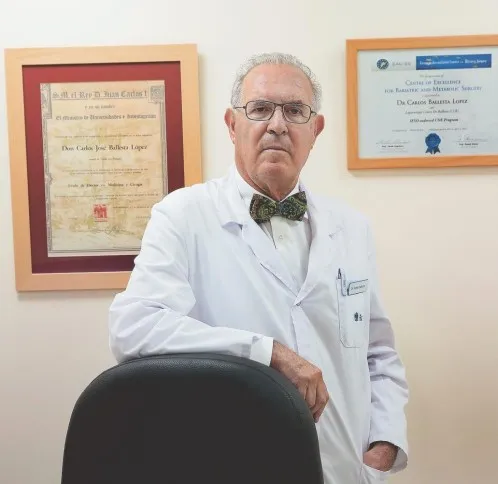Dr. Carlos Ballesta López/ Director of the Ballesta Laparoscopic Center, Ruber International Hospital (Quirónsalud Group).
1 -The May clinic proposes the change of BMI (body mass index) by that of IVC (body volume index).What advantages do you have?
We already made this proposal in the laparoscopic center that I directed and we reflected it more than a decade ago when we published the "ABC of obesity surgery."The main advantage is that it is a more precise and reliable method than the BMI to diagnose the severity of the disease and metabolic diseases (diabetes, hypertension, etc.) that accompany obesity;although it is more difficult to calculate for the general population.
2 What is the BMI weight/size²?
It is a calculation that allows us to measure the degree of obesity, not its gravity (associated diseases).There are patients who with weights of 200 kg and BMI greater than 60 have associated diseases (diabetes, hypertension, etc.).While there are others that with a weight of 100 kg and BMI of 33 or 34 (less than 35) already have diabetes, hypertension or serious heart problems.The latter would be better detected with the IVC.
3 -What differences are between BMI and IVC?
The main difference, for citizens to understand, is that the BMI indicates the amount of fat of the person and the IVC indicates how that fat and the severity of obesity is distributed.Or, what is the same, if obesity is central or peripheral.The first is more common in men (brewing belly), and the second in women (buttocks and legs).Central obesity is more frequently associated with diabetes, hypertension, high cholesterol and myocardial infarction risks.We to assess the risks of obesity propose the ICC (hip waist index) that in men is 0.78-0.94 and in women of 0.71-0.84.It would be the equivalent of calculating the IVB or IVC (acronym in Spanish of the body volume index).
4 -What advantages would I give the change of BMI to IVC?
The advantages are clear: an early detection of serious obesity and an early indication of surgery, before diabetes, hypertension, etc. appear.and above all a more precise indication of the type of operation to be performed (Sleeve, Gastric By-Pass, Metabolic By-Pass or Duodenal Switch).Clearly differentiating when Sóolo surgery has to be performed to lose weight and when it has as a mission, in addition to losing weight, healing associated diabetes and comorbidities.
5 -Are an operation that heals diabetes?
Yes, today we have an operation that cures type 2 diabetes. It is the result of long years of research that in the laparoscopic center began in 1995 and has marked the way forward.In these years it has changed, evolving, the concept of the indication of surgery and disease.Going from operating morbid obese with type 2 diabetes, to operate diabetics to which they had a few kilos, which is known today as diabhesity, and finally operate to type 2 diabetics with Normapeso.
Operations are different depending on one situation or another.This surgery, which is performed by laparoscopy, allows rapid recovery, reducing the number of infections and complications.and remaining patients entered between 48 and 72 hours after surgery.
6 -What difference is there between obesity and metabolic surgery?
Obesity surgery aims at weight loss by gastric reduction with or without modification of intestinal absorption.Metabolic surgery aims to act on hormones that interacting with the pancreas that are responsible for diabetes;It is associated with weight loss or not.There are several surgical procedures that are used, both in obesity surgery and in metabolic surgery.Although they are the gastric "By-Pass and the Metabolic By-Pass the most used in all the centers that perform this surgery.
7 -What type of recovery do these patients need?
The recovery of the patients depends on the specific characteristics of each case, age, severity of diabetes, weight (BMI) and other associated diseases of each case.It varies between 48 hours and 72 hours of hospitalization, initiating the wandering and oral diet the morning after the surgery.Two weeks after the operation are allowed intercontinental trips and, per month, all kinds of physical activity and sport.Care are simple and it is only necessary to modify eating habits in some cases.
8 -What are the indications of obesity and diabetes surgery?
The indications of obesity surgery are unanimous in all hospitals.BMI greater than 35 when they present comorbidities such as diabetes, hypertension or SAOS (CEPAP carriers).BMI equal to or greater than 40, even if there are no comorbidities.The indications of type 2 diabetes surgery, as the 1 does not respond to surgery, focus on the fact that there is still pancreatic reserve (peptic C greater than 1) and do not have pancreatic antibodies.
9 -What weight loss is achieved after surgery?
It depends on the degree of obesity of the patient.It is different pre-ribid obesity BMI of 35 kg/m2 (35 kilos are left over to the patient).A morbid obesity with BMI greater than 40 kg/m2 or EMC extreme obesities greater than 50 or 60, more than 100 kg of weight is left over.In the first case it loses eight or ten kilos a first month and between 35 and 40 kilos the first year.In extreme cases they lose between 16 and 20 kilos the first month and between 100 and 150 kilos the first year.
10 -What results are obtained in diabetes surgery?
It depends on each patient and the functioning state of their pancreas.We have patients who clicking 100 units of daily insulin, a week do not need to put any.In other cases they can take between six months and one year.The most important thing is that between healing and diabetes improvement, after surgery we exceed 90%.


